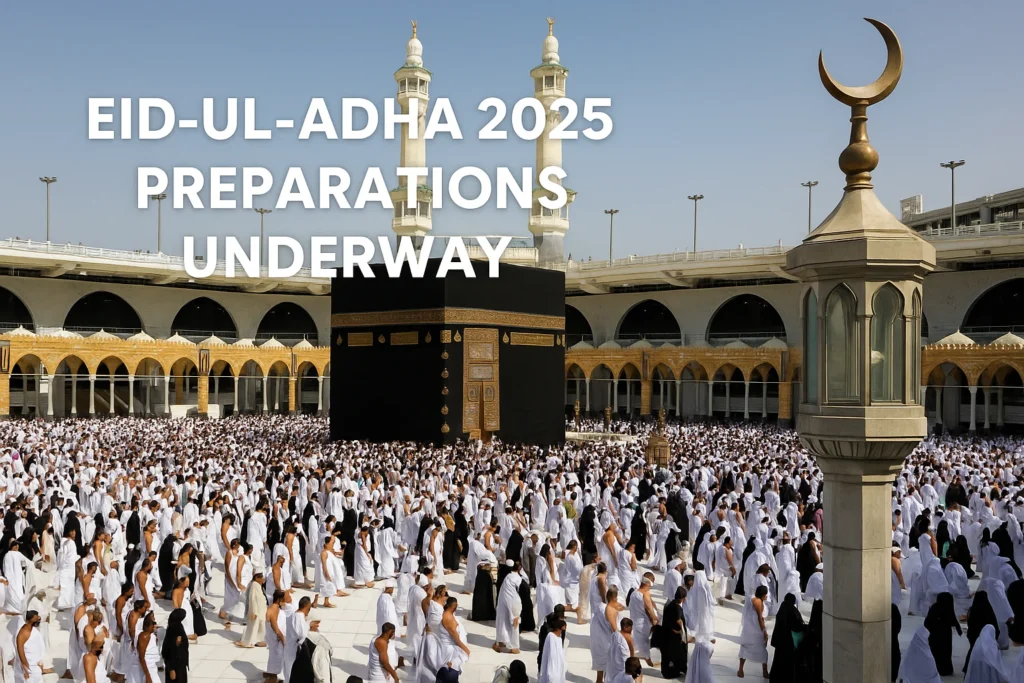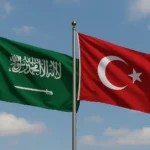Introduction: A Whisper of Celebration in the Air
Imagine a special time of year when millions of hearts turn towards a single, sacred purpose. It’s a period filled with deep spiritual meaning, vibrant traditions, and a powerful sense of community that stretches across continents. This is the atmosphere currently building across the Arab world, as preparations are in full swing for Eid-ul-Adha 2025. This isn’t just a holiday; it’s a profound spiritual event, intricately linked to one of the most important pilgrimages in the world.
The air is thick with anticipation, from bustling marketplaces stocking up on festive goods to the quiet solemnity of individuals preparing for a momentous journey. Saudi Arabia has announced the official date, marking the culmination of careful observation and tradition. Let’s step into this world of faith, devotion, and joyous celebration, understanding the deep roots and widespread impact of this significant occasion.
The Moon’s Decree: How Eid-ul-Adha is Dated
For Muslims around the globe, the date of Eid-ul-Adha isn’t just marked on a calendar months in advance. It’s determined by a timeless ritual: the sighting of the new moon. This celestial event ushers in the month of Dhul Hijjah, the twelfth and final month of the Islamic calendar, and sets the stage for both the annual Hajj pilgrimage and the subsequent Eid celebration.
The Dhul Hijjah Crescent Moon
Saudi Arabia, home to Islam’s holiest sites, plays a central role in this determination. On Thursday evening, May 29, 2025, authorities in Saudi Arabia would have commenced the official sighting of the Dhul Hijjah crescent moon. This careful observation, often carried out by religious scholars and experts, is crucial. If the crescent moon is successfully sighted, it officially marks the beginning of Dhul Hijjah.
Based on this sighting, the announcement was made: Eid-ul-Adha 2025 will be observed on Friday, June 6, 2025. This means that the day before Eid-ul-Adha is the Day of Arafah, a pivotal day for Hajj pilgrims, which would fall on Thursday, June 5, 2025. This method of lunar observation connects the faithful directly to the natural world and centuries of Islamic tradition.
The Hajj: A Journey of a Lifetime
Central to the period leading up to Eid-ul-Adha is the Hajj pilgrimage. This incredible journey to Mecca, Saudi Arabia, is one of the five pillars of Islam, a spiritual obligation that every Muslim who is physically and financially able is expected to undertake at least once in their lifetime. It’s a profound experience of devotion, unity, and spiritual purification.
A Confluence of Millions
As Eid-ul-Adha approaches, preparations reach a fever pitch in Saudi Arabia, particularly in the holy cities of Mecca and Medina. Millions are expected to participate in the Hajj pilgrimage, undertaking a series of sacred rituals that reenact the steps of prophets like Abraham and Muhammad. This year, meticulous planning is underway to ensure the safety, comfort, and spiritual fulfillment of pilgrims arriving from every corner of the world.
The scale of the Hajj is truly immense. Imagine millions of people, dressed in simple white garments, performing the same rituals at the same time, united by faith. It’s a powerful visual testament to the global brotherhood and sisterhood of Islam. For those embarking on this journey, it’s not just a physical trip; it’s a deeply transformative spiritual experience, a chance to cleanse sins and renew their connection with God.
The Significance of Eid-ul-Adha: Sacrifice and Devotion
Eid-ul-Adha, often translated as the “Festival of Sacrifice,” holds profound spiritual meaning. It commemorates the willingness of Prophet Ibrahim (Abraham) to sacrifice his son, Ismail, in obedience to God’s command, before God replaced Ismail with a ram. This act symbolizes ultimate devotion, submission, and faith.
The Ritual of Qurbani
A central ritual of Eid-ul-Adha is the Qurbani, or sacrifice, of an animal (typically a sheep, goat, cow, or camel). This act is not about shedding blood, but about remembering Ibrahim’s devotion and sharing blessings with the less fortunate. The meat from the sacrificed animal is traditionally divided into three parts:
- One-third for the family.
- One-third for relatives and friends.1
- One-third for the poor and needy.
This sharing aspect highlights the strong emphasis on charity, compassion, and community spirit that defines Eid-ul-Adha. It’s a powerful reminder of responsibility towards others and the importance of giving.
Preparations Across the Arab World: A Season of Joy
Beyond the solemnity of Hajj, the arrival of Eid-ul-Adha sparks widespread preparations and joyous celebrations across the entire Arab world. From grand capital cities to small villages, families and communities come alive with festive energy.
Bustling Markets and Festive Feasts
The days leading up to Eid see marketplaces buzzing with activity. People shop for:
- New Clothes: It’s a tradition to wear new clothes for Eid prayers and family gatherings, symbolizing renewal and celebration.
- Food Supplies: Special ingredients for elaborate feasts are bought, including fresh meats for the Qurbani, spices, and ingredients for traditional desserts.
- Gifts and Decorations: Homes are decorated, and gifts are prepared for children and loved ones.
The scent of traditional dishes fills the air as families prepare large meals to share. This focus on food and family gatherings is a cornerstone of Eid celebrations, fostering connection and strengthening bonds.
Community and Charity
Eid-ul-Adha is also a time for heightened charity. Beyond the distribution of Qurbani meat, people make extra efforts to donate to charities, help those in need, and ensure that everyone can partake in the festivities. This communal spirit is a beautiful hallmark of the holiday, extending its blessings to all members of society.
The Pilgrim’s Journey: Logistics and Devotion in Mecca
For the millions performing the Hajj pilgrimage 2025, the preparations in Mecca and Medina are nothing short of monumental. Saudi authorities undertake an immense logistical operation to accommodate pilgrims from diverse backgrounds, ensuring their journey is safe, organized, and spiritually fulfilling.
A City Transformed for Pilgrims
Mecca, the spiritual heart of Islam, transforms into a global village during Hajj. Roads, accommodation, medical facilities, and transportation systems are all geared towards supporting the pilgrims. Specialized teams work around the clock to manage the flow of millions around the Kaaba, the grand mosque, and other holy sites.
Pilgrims arrive dressed in simple white garments called ‘Ihram’, symbolizing equality and purity before God. They undertake a series of specific rituals, including:
- Circumambulating the Kaaba (Tawaf): Walking around the sacred structure seven times.
- Safa and Marwa: Walking between the hills of Safa and Marwa.
- The Day of Arafah: Standing on the plains of Mount Arafah, a pivotal moment of prayer and reflection.
- Ritual of Stoning (Ramy): Symbolically casting stones at pillars representing temptation.
These rituals of Eid-ul-Adha and Hajj are performed with deep devotion, representing a profound spiritual journey that culminates in the celebration of Eid.
Embracing Unity: The Global Impact of Eid-ul-Adha
While the core celebrations are rooted in the Arab world, the impact of Eid-ul-Adha resonates globally. Muslims in every country observe the holiday, sharing its message of sacrifice, gratitude, and communal solidarity.
A Global Tapestry of Faith
From bustling cities like Jakarta and London to quiet villages in Africa and Asia, families gather for special prayers, exchange gifts, and share meals. The uniformity of the rituals—the morning prayers, the Qurbani, the emphasis on charity—creates a powerful sense of unity across diverse cultures. It’s a time when differences fade, and shared faith shines brightest.
The sight of millions performing Hajj and billions celebrating Eid-ul-Adha serves as a powerful reminder of the vastness and diversity of the Muslim world, united by common traditions and spiritual aspirations. It reinforces the idea that despite geographical distances, a deep spiritual bond connects individuals through shared values and devotion.
Festive Flavors and Family Gatherings: The Heart of Eid
Beyond the spiritual rituals, Eid-ul-Adha is deeply intertwined with culture, family, and the joyous act of sharing food. The days of Eid are a cherished time for strengthening family bonds and extending hospitality.
A Culinary Journey
Every region has its own special Eid dishes, making the holiday a culinary adventure. In the Arab world, this might include:
- Hearty Meat Dishes: Reflecting the Qurbani, dishes featuring lamb or beef are central, prepared in various traditional ways like roasted lamb (Mandhi or Kabsa in some areas), stews, or kebabs.
- Sweet Treats: A wide array of pastries, cookies, and desserts are prepared and shared, often accompanied by strong Arabic coffee or tea. These might include Ma’amoul (date-filled cookies), Basbousa (semolina cake), or a range of local sweets.
- Gatherings and Visits: Families visit each other, exchanging greetings, good wishes, and gifts, especially for children who often receive “Eidiya” (money gifts).
The warmth of these gatherings, the laughter of children, and the delicious aromas are what make Eid-ul-Adha a truly memorable and beloved holiday for millions.
Conclusion: A Celebration of Faith, Family, and Generosity
As the moon dictates the rhythm of the Islamic calendar, the announcement of Eid-ul-Adha 2025 on Friday, June 6, 2025, has set in motion a period of profound spiritual reflection and joyous communal preparation across the Arab world. From the meticulous planning for the Hajj pilgrimage in Saudi Arabia, where millions will converge in a display of unwavering faith, to the bustling markets and homes filled with the anticipation of festive gatherings, the energy is palpable.
This sacred occasion, commemorating Prophet Ibrahim’s ultimate act of devotion, reminds Muslims globally of the importance of sacrifice, charity, and submission to a higher purpose. The widespread preparations in the Arab world, marked by new clothes, elaborate feasts, and acts of generosity, underscore the holiday’s emphasis on family, community, and sharing blessings with the less fortunate. Eid-ul-Adha is not merely a date on the calendar; it is a vibrant tapestry of faith, culture, and human connection, a time for renewed devotion and celebration that resonates far beyond its traditional heartlands.



